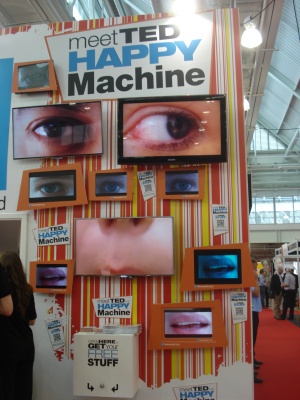If I had to define in a sentence what the In-Store Show pavilion at the Marketing Week Live event was about, I would say it mostly presented solutions to make marketing more engaging.
In terms of technology, it was very similar to what we already saw this year at Screenmedia Expo. Large thin-vessel HD displays, some LED, picture frame-type screens, a few holograms, 3D and transparent displays.
For instance, Crystal Display Systems (CDS) had already introduced its 22" (0.6m) transparent showcase box at Screenmedia Expo. The ClearVue 220 allows the combination of a real product displayed in a presentation box and graphics or video content played in front on it, on a transparent display. However, what was new at this show was CDS's 46" (1.2m) box, also plug-and-play, but more impressive. Other companies showing transparent displays were Media Zest and Stratacache, with a large drinks dispenser fridge with a transparent screen.

TED, the happy machine, gave out 'free stuff' and interacted with visitors
Something that caught my eye in terms of screen technology was the use of 4.3" (11cm) TFT LCD displays used for shelf-edge applications or as mini video displays for counter advertising – or even inside a card. The screen is more or less the size of a smartphone screen, but is lighter. The resolution in that size is very good and the screens can display individual or joined content. The only fault, especially if the screens are used next to each other, is that they have quite a thick frame so the image is not continuous.
The mini displays inside cards were designed by Display Innovations and have a video that is activated when the card is opened, and that can play for the battery's life of three hours. Pixel Inspiration has combined its version of digital shelf-edge display with a QR code reader, so the screens play content continuously until a QR code is scanned, which triggers information on the product to pop up on the screen.
CDS was also demonstrating its shelf-edge display. "The displays work like a desktop extension," explains managing director Chris Bartram. "You can decide what you put on each screen or run an image across several. It's a PC interface so you can use any media player from signagelive, Scala or any other. The maximum number of TFT 4.3' (1.3m) screens you can put in one line is eleven, but we can daisy-chain them to link together up to 72 displays."
One particular product that was being showcased by many companies was Christie's MicroTiles. The versatile cubic rear projection display was present in at least six different stands, and not just on the In-Store Show pavilion, but the Live Marketing area, which was for companies offering exhibition stands, as well. Equinox Design had the largest Christie MicroTiles display, a five by eight array. The show's entrance hall had a MicroTiles display, as did system integrator Saville Audiovisual, distributor Aztec and content designer Beaver Group, to name but a few.
An innovative store concept which attracted crowds was the one presented by H Squared. Its name was TED, the happy machine. TED stands for Technology Engagement Device, and combined screens and mobile technology. Visitors were handed a card to fill in, or by scanning a QR code they were taken to a website. Here they were given a virtual scratch card to reveal whether they had won, and what time they needed to go to the stand to get their 'free stuff'. TED was a videowall comprised of several screens with videos of eyes and mouths. At the time arranged for people to come and collect their prizes, TED came alive as an interactive screen, seeing the bystanders (via a webcam) and talking to them. Winners needed to open a small box to find their goodies.
But how can these solutions work together? The entrance of the In-Store Show had concept stands, showing what the future of retail can be. I must say I didn't think much of these. IBM had created a 'shoe shop fusion', with screens on the shop window showing tweets and live models parading in the window as if it were a catwalk. The twist, and where IBM technology came in, was that the public tweeted what shoes they wanted to see modelled. IBM proposes using a multi-channel experience to engage customers at various levels and feedback to the retailer through its analytics.
The show covered all areas of marketing and communications, and was worth a visit.